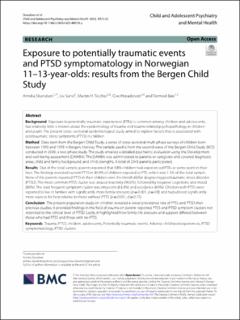Exposure to potentially traumatic events and PTSD symptomatology in Norwegian 11–13-year-olds: results from the Bergen Child Study
Journal article, Peer reviewed
Published version

Åpne
Permanent lenke
https://hdl.handle.net/11250/3094075Utgivelsesdato
2023-03-04Metadata
Vis full innførselSamlinger
Originalversjon
Child and Adolescent Psychiatry and Mental Health. 2023, 17 (1), 32. 10.1186/s13034-023-00578-ySammendrag
Background: Exposure to potentially traumatic experiences (PTEs) is common among children and adolescents, but relatively little is known about the epidemiology of trauma and trauma-related psychopathology in children and youth. The present cross- sectional epidemiological study aimed to explore factors that is associated with posttraumatic stress symptoms (PTSS) in children.
Method: Data stem from the Bergen Child Study, a series of cross-sectional multi-phase surveys of children born between 1993 and 1995 in Bergen, Norway. The sample used is from the second wave of the Bergen Child Study (BCS) conducted in 2006, a two-phase study. The study entailed a detailed psychiatric evaluation using the Development and well-being assessment (DAWBA). The DAWBA was administered to parents or caregivers and covered diagnostic areas, child and family background, and child strengths. A total of 2043 parents participated.
Results: Out of the total sample, parents reported that 4.8% children had experienced PTEs at some point in their lives. The findings revealed current PTSS in 30.9% of children exposed to PTE, which was 1.5% of the total sample. None of the parents reported PTSS in their children over the threshold for diagnosing posttraumatic stress disorder (PTSD). The most common PTSS cluster was arousal reactivity (90.0%), followed by negative cognitions and mood (80%). The least frequent symptom cluster was intrusions (63.3%) and avoidance (60%). Children with PTSS were reported to live in families with significantly more family stressors (p = 0.001, d = 0.8) and had utilized significantly more sources for help relative to those without PTSS (p = 0.001, d = 0.75).
Conclusion: The present population study on children revealed a lower prevalence rate of PTEs and PTSD than previous studies. It provided findings in the field of trauma on parent- reported PTSS and PTSD symptom clusters not restricted to the clinical level of PTSD. Lastly, it highlighted how family-life stressors and support differed between those who had PTSS and those with no PTSS.
